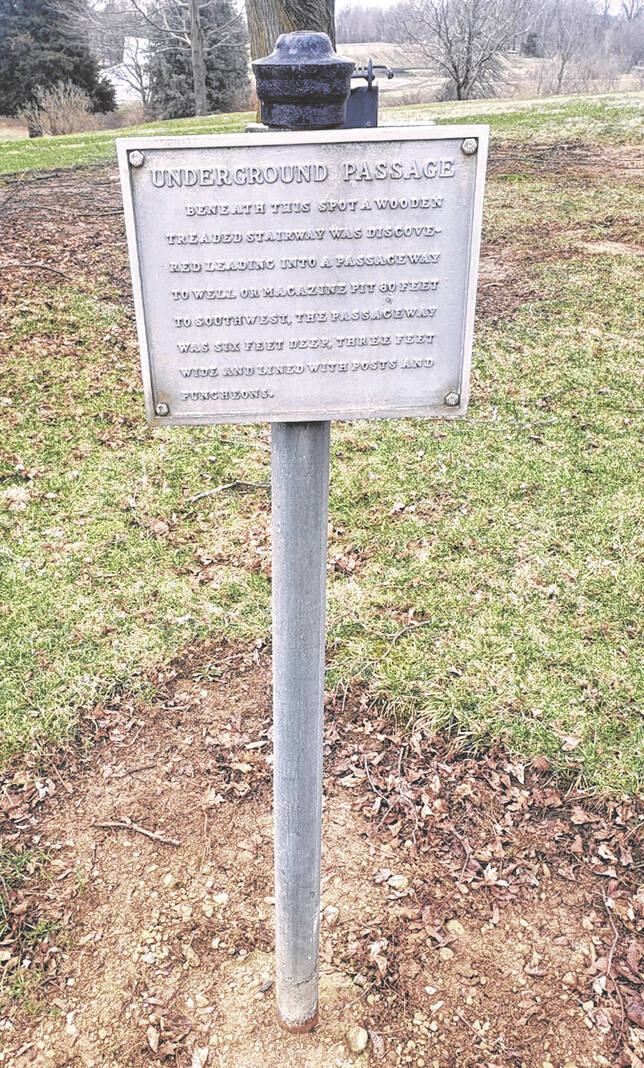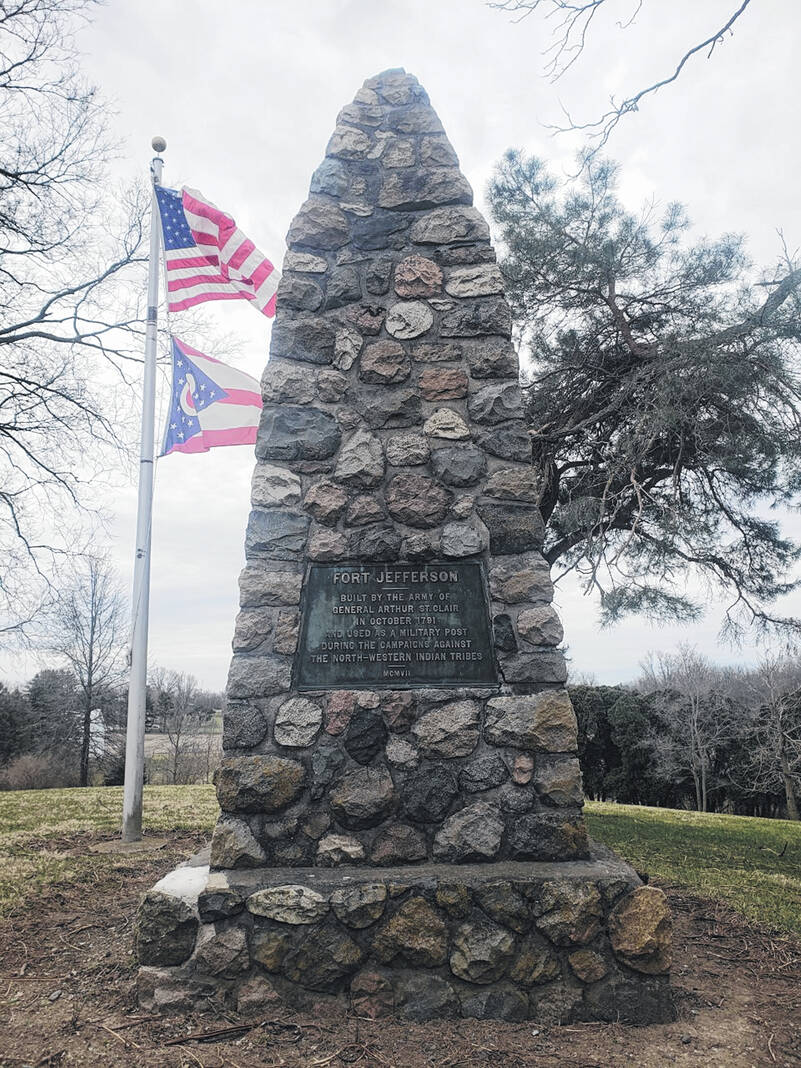
One of DCP’s goals for Fort Jefferson Memorial Park, is to install new, more readable, interpretive signs. This sign describes the discovery of an underground passage, leading to a well or magazine pit.
Tammy Watts | Daily Advocate

The granite monument to Fort Jefferson was dedicated on Oct. 24, 1907.
Tammy Watts | Daily Advocate
By Tammy Watts
DailyAdvocate.com
GREENVILLE — At first glance, the six gently rolling acres comprising Fort Jefferson Memorial Park in Neave Township, five miles south of Greenville, appear to be a picturesque rest area. Apart from an imposing 20-foot granite monument, the tranquil slopes and proximity of surrounding houses suggest little more than a neighborhood park, belying the historical significance of the site. The tract, however, was the location of Fort Jefferson, built during the “Indian Wars” of 1790-1795. As the burgeoning American population moved north of the Ohio River, Native Americans began attacking white settlers to defend their territory.
In October 1791, General Arthur St. Clair, Governor of the Northwest Territory, embarked on a mission to take revenge on the tribes people, and ordered his forces to build Fort Jefferson. Named for then Secretary of State Thomas Jefferson, the fort was part of a chain of such garrisons, starting with Fort Washington in what is now Cincinnati. As St. Clair advanced northward, he was defeated at the hands of the Miami, Shawnee, and Mohawk, led by Chief Little Turtle, Blue Jacket, and Chief Brant, respectively. Survivors retreated 29 miles back to Fort Jefferson; six hundred soldiers had been killed, and 300 were wounded, in the worst defeat ever of U.S. forces by indigenous peoples.
Two years later, the fort played a pivotal role as a supply base during General Anthony Wayne’s campaign, resulting in his victory at Fallen Timbers, and setting the stage for the 1795 Treaty of Greenville. Although it was a key station, it had been relegated to an auxiliary after the establishment of Fort Greene Ville in 1793, the largest fort in North America at the time. Fort Jefferson was abandoned in 1796, and soldiers were ordered to burn it to the ground. Today, nothing remains for visitors to see of the original fort structure; however, partially burned timbers were found in the bottom of a pit during a 1930 archaeological excavation of the site.
Throughout the last two centuries, interest in Fort Jefferson’s history has remained strong. The Fort Jefferson monument was constructed in 1907 by the Greenville Historical Society, and the surrounding area became a state memorial park in 1929. It was established as a roadside park, or rest area, in 1940; Ohio Department of Transportation (ODOT) and the state of Ohio still retain ownership of the property. A couple of Ohio historical markers were added in 2003, with information about the fort, and St. Clair’s defeat, in honor of the state’s bicentennial.
In July 2021, Darke County Parks (DCP) assumed responsibility for maintaining the park from the Darke County Board of Commissioners. Ohio History Connection (OHC) oversees archaeological interests inside the park, and DCP is under contract with OHC, receiving payment for its maintenance and upkeep of the property. Additionally, DCP made recent improvements through a capital funds request to OHC, removing the decades-old bathrooms, and re-paving to make the area wheelchair accessible. DCP wants to continue improving the park, such as installing new benches for the picnic area, and adding more readable interpretive signs, to educate the public about the park’s long history.
The Friends of Fort Jefferson, a 501(c)(3) nonprofit organization, has done archaeological digs in the area, discovering musket balls, axes, and buttons worn by the soldiers of Fort Jefferson. The group’s website, friendsoffortjefferson.org, states that they are “purposed toward acquiring and sharing historical/cultural information about the building, settlement, and accomplishments of Ohio’s Fort Jefferson during the 1790s.” They will be holding a re-organizational meeting on Thurs., April 21 at 6 p.m. in the assembly room of Shawnee Prairie Preserve and Nature Center. Bill Light is scheduled to speak, and will be discussing ideas for the recently purchased 17 acres south of Fort Jefferson Memorial Park, which could include building an interpretive center, museum, and/or library.
Daily Advocate reporter Tammy Watts can be reached at [email protected].

